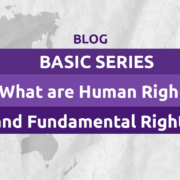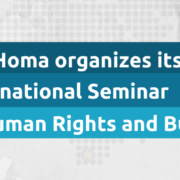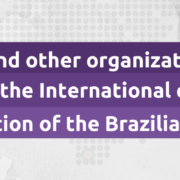What is the Universal Declaration of Human Rights?
On December 10, 1948, at the United Nations General Assembly in Paris, the Universal Declaration of Human Rights (UDHR) was signed, and since then it has become the most translated document in the world* and inspired the constitutions of several democracies and recent States. In our Basics Series of the week, we are going to explain a little more about this document that is so important in the history of human rights.
The UDHR was created through the “Resolution 217 (III)”, of the General Assembly, after the World War II. It is worth mentioning that the end of the Second World War was a milestone for the formation of the Classical International Law – based on the logic of the State being the only one targeted by the International Law and of the coexistence between nations – for Contemporary International Law – grounded in the inclusion of other subjects alongside States, such as international organizations and, more recently, the individual, and in the collective security system, strongly marking the cooperation between States.
Given this context, the international community decided to assume the commitment with the basic values for the conservation of peace, democracy, and people’s development. Therefore, the Text is a compilation of presupposition materials that aim to guarantee a minimum for the individual’s subsistence, being based on a fundamental premise: its universality occurs due to the inherent human situation. Thus, it arose by the necessity of sufficiently defining the rights of the Charter of the United Nations -most importantly the meaning of the expressions “fundamental liberties” and “human rights”, – created in 1945 as a fundamental UN treaty, the compliance was mandatory for all the State members of the organization.
The document was mainly sketched by the Canadian John Peters Humphrey, a jurist defendant of the human rights, at the time, he had been recently indicated as director of the human rights division inside the UN secretary. However, the declaration also had the support of people around the world, and was adopted by the General Assembly with forty-eight votes, none against it, and eight abstentions. In that sense, it is important to mention that the UN prerogative for a consensus strategy – through the approval of a document without any vote against it – was achieved. It is possible to notice that, without dismissing the Declaration importance, it is the work of a classic liberal conception of Human Rights.
Because it is a declaration and not a treaty, the UDHR is not a document with legal obligatory compliance, and doesn’t have the binding aspect between the signatory countries. However, because it is already internationally established, the Declaration signatory countries governments commit, alongside the civil society, to take continuous measures that assure the recognition and compliance of the human rights announced on the document. Nowadays, the UDHR text is already considered jus cogens. Although all the effort, in practice, many countries frequently end up not complying with the Declaration.
The document has been translated into more than 500 languages since its creation, and although it doesn’t have a binding mechanism, it still being mentioned by several academics and institutions, besides being of use to the creation of two treaties on human rights at UN of legal force, the International Covenant on Civil and Political Rights, and the International Covenant on Economic, Social and Cultural Rights.
Brazil was one of the fifty-eight State-members of the United Nations at the time that the declaration was signed. The document has 30 articles that proclaim the rights and human individual liberty, some of those being the right to be born free and equal, recognized as people and worthy of the legal protection, presumption of innocence until proven guilty. The Declaration also highlights its position against the interference in private individual life, torture, cruel punishments and arrests or arbitrary exiles.
For that reason, the UDHR is considered a constitutive document of the United Nations, that delimit the fundamental basic rights of the human being in a universal manner, drawing an action guide and rules to be respected and followed, that contemplate democracy principals, citizenship and peace in general. It is also because of the declaration creation date that the International Day of Human Rights is yearly celebrated in December 10.
*Guinness Book of World Records












Leave a Reply
Want to join the discussion?Feel free to contribute!